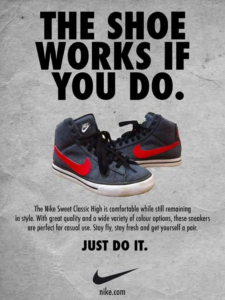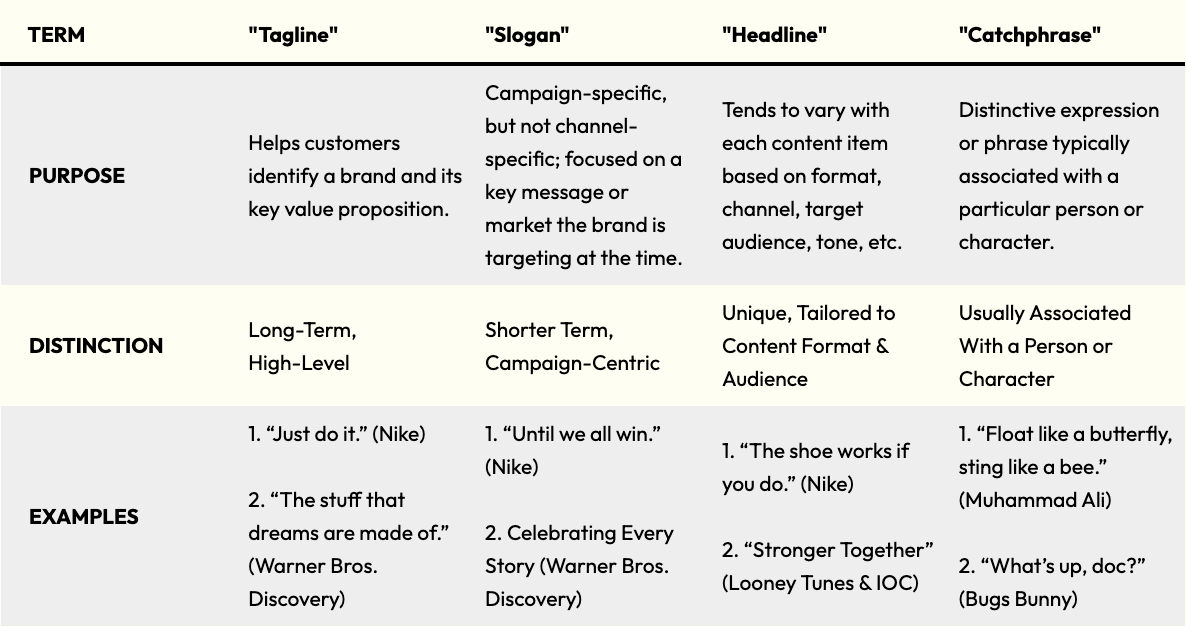
In the dynamic realm of marketing, the term “tagline” is often tossed around, yet even seasoned professionals are sometimes confused about its precise meaning. Even within an organization, different departments may have a different idea of what a tagline is, creating confusion and collaborative friction.
Have you or a colleague ever stopped to ask, “What exactly is a tagline?” And how does it compare with terms that sometimes get used interchangeably—such as a slogan, headline, or catchphrase? Questions around the overlap of these terms are common and understandable, but aligning your business around ubiquitous terminology can prevent misunderstandings and help streamline your processes.
What’s often perceived as a simple message in marketing can, in fact, be a battleground of nuances, where every word is a strategic choice that can elevate or undermine your brand’s message. So, let’s explore the ins and outs of taglines.
At its core, the purpose of a tagline is to help customers identify a brand and its marketing message. A tagline should be unique to the brand, memorable, and relevant. Taglines tend to appear alongside a company’s brand name or logo, and do not typically change often over time or across different campaigns.
Think of Nike’s “Just do it.”
Taglines are strategic tools crafted to convey the quintessence of a brand’s identity and values in a compact form. The best taglines may be catchy, sure, but they also encapsulate a message that resonates with the target audience, evoking emotions or creating associations that endure. They can carry a lot of weight in shaping consumer perceptions and brand identities.
Similarly, a catchphrase is a distinctive expression or phrase that is often associated with a particular person, character, or brand. For the sake of clarity, we think of a tagline as being more formal and broadly applicable to a business than a catchphrase, which can often be tied to a brand representative or mascot.
For example, the Warner Bros. Discovery tagline is, “The stuff that dreams are made of.” Bugs Bunny (one of Warner Bros Discovery’s most famous characters), on the other hand, is known for his catchphrase, “What’s up, doc?”

You’ve likely heard someone use the terms “tagline” and “slogan” interchangeably, an issue that happens more when communicating across sectors, like advertising and public relations. While both taglines and slogans are vital tools in branding and marketing, they serve different purposes.
Unlike a tagline’s permanent role associated with a brand’s overarching identity, a slogan is typically campaign-specific and can change depending on the particular message or market the brand is targeting at the time. This distinction can be crucial, as it influences the strategic deployment and creative process.
Below are a couple of example slogans:
Misidentifying a tagline as a slogan, for example, could result in frequent changes that disrupt brand consistency and dilute consumer perceptions of stability and reliability. Forbes highlights the importance of consistency in branding, noting that consistent, strategic branding leads to strong brand equity.
Reducing ambiguity and preventing confusion across teams from varying backgrounds and experience levels is essential to achieving your overarching business goals. It’s a challenge that extends to brands of all sizes and business models, whether you handle marketing in house or work with expert agencies.
Note that the general public may not be aware of the strategic nuances between the terms either.

Not exactly. Headlines tend to vary with each asset or content item, tailored to the format, target audience, purpose, and tone of the specific content—they are not static across a campaign (slogan) or permanent to a brand (tagline).
Typically used in advertising and media, headlines are meant to attract immediate attention and are often newsy or sensational in nature, generally used in a specific email, blog, or other content asset.
Below is an example of a strong headline from Nike:

The example from Nike above includes both a strong headline, “The shoe works if you do.” and the iconic tagline, “Just do it.”
Taglines require more strategic depth and broader application than headlines. They should transcend immediate product features or promotions and tap deeper into emotional resonances with the audience. A misunderstanding around the purpose and value of a tagline could dilute your brand’s cohesive identity.
Confusion will arise during the branding process if your clients and/or creatives overlook the necessity of aligning your tagline closely with your brand’s long-term vision, rather than viewing it as a more dynamic and temporary campaign slogan or content headline.
While there can be some overlap between the common marketing terms below (e.g. an extremely successful slogan or headline could become a brand’s tagline), the table gives you a general idea of their differences.


Catchiness alone doesn’t guarantee the success of a tagline. It must, more importantly, represent the brand’s values and identity and resonate with the target audience.
For example, when diamond company De Beers’ tagline, “A Diamond is Forever”, launched in 1947, it stuck—not only because it was catchy, but because it effectively communicated the enduring value and emotional investment in a diamond. The tagline aligned perfectly with societal values about marriage and commitment at the time.
The most memorable taglines often use metaphors or play on words to evoke emotions or create vivid images. But overly complex taglines that aim for cleverness may fail to communicate effectively.
Marketing Week discusses how simplicity and clarity in branding often outperform complexity by making brands more approachable and easier to understand. We see this in some of the most successful taglines in history, including the legendary McDonald’s tagline, “I’m lovin’ it.” Taglines that don’t overcomplicate the message are more memorable and pervasive. There’s also an increasing belief that taglines should prioritize clarity and be direct descriptions of a product or service.

Creating a tagline that resonates deeply with both the brand and its audience is an art form that demands precision. Your tagline must align its words with your brand’s core identity and the values it aims to communicate.
For example, BMW’s “The Ultimate Driving Machine” succinctly captures the brand’s emphasis on providing a superior driving experience. The tagline aligns with BMW’s identity as a luxury automaker that prides itself on engineering excellence.
A tagline’s cultural relevance contributes significantly to its emotional impact. But language that resonates in one cultural context may not work as well in another.
That fact has become evident in some multinational company taglines, which often adapt to fit the local languages or cultural nuances of an international audience through transcreation. Transcreation is the process of adapting content from the source language to the target language while maintaining the existing tone, intent, and style. It’s not always a cut and dry or direct translation.
The BMW tagline above highlights the importance of transcreation, rather than direct translation, when developing culturally resonant taglines. When BMW, a Bavarian company, translated the German tagline, “Freude am Fahren” to “the joy of driving”, it did not have the same powerful effect in America. Blueprint outlines how BMW adapted the tagline to appeal to Baby Boomers who “longed for symbols of prosperity and status,” landing on “The Ultimate Driving Machine”.
In contrast, Coca-Cola’s “Open Happiness” campaign slogan, launched in 2009, is an excellent example of a successful global phrase that maintained emotional appeal overseas. Another great international slogan is McDonald’s “I’m loving it,” the result of a competition between 14 international ad agencies, large and small!
The winning firm, a small studio called Heye & Partner from Germany, pitched the idea: “ich liebe es,” which translates to “I love it.” McDonald’s debuted the campaign in Germany in recognition of the winning agency’s role and then rolled out the English version in the US, UK, and Australia. The slogan has gone on to become by far the longest-running McDonald’s slogan in history, and still stands strong today.
Studies on linguistic precision in branding suggest that the most effective taglines often include language that holds one meaning to one group of consumers and something different to another. A study detailed in the Journal of Advertising illustrates how polysemic taglines can enhance consumer engagement by activating different layers of meaning. It posits that consumers enjoy the process of deciphering the meanings, which makes the tagline more memorable and enhances the perception of the brand.
Nike’s classic “Just do it” is a perfect example. While simple on the surface, the tagline resonates differently with a young, ambitious athlete than it does with a father in his 50s trying to get back into shape. The tagline impacts both groups but in different ways.
The interplay between a tagline’s clarity and its ability to engage emotionally is critical. Research has demonstrated that emotional content is more likely to be remembered than non-emotional content.
A study by Kensinger and Corkin (2003) in Memory & Cognition details how emotional information enhances memory by engaging cognitive resources that mediate attention and memory consolidation. Taglines with emotional appeal can create a strong connection between the brand and its audience, which is crucial for both purchasing decisions and brand loyalty.

Marketing and ad experts tend to agree that a tagline is valuable for branding, even though some suggest taglines may not be necessary for every brand in the digital era. But while a static tagline may be challenging to adapt to the target audiences of different social channels, a brand’s tagline does not need to be repeated in every message, social post, or blog post.
Companies now have multiple channels to tell their stories and engage with consumers through interactive journeys and campaigns. Marketing experts are divided on the issue. Forbes’ Denise Lee Yohn reports that memorable taglines are in decline and that perhaps the more modern hashtag is taking their place.
Meanwhile, Adweek’s Stu Watson suggests that taglines are not obsolete, but they are in need of evolution. He explains that this generation “won’t be taken in by [a tagline’s] simplistic charm.” However, a 2020 survey by The Manifest reported that 50% of people look to a tagline as a way to understand a company’s purpose, further complicating the discourse.
Ultimately, a multi-channel approach allows for more nuanced and varied communication, which can drive very different results than a single, overarching tagline. Your messaging approach should align with your business goals, campaign scope, and target audience. There is no “correct” perspective—only the best strategy for your business.
In practice, understanding the distinction and appropriate application of a tagline can matter greatly and impact your business results. Shared terminology among brand stakeholders supports more effective conversations and strategies that can foster greater brand loyalty, recognition, and growth.
Your brand tagline should ultimately depend on your company. What is the nature of your industry? What are the behaviors of your target audience(s)? What communication channels are most relevant?
Navigating the complexities of taglines and branding can be a daunting task. If you’re ready to enhance your brand’s impact with branding that genuinely resonates, we can help. Agital specializes in crafting compelling and powerful brand narratives that capture your business and connect with your audience.
Contact us today to start your branding journey with experts who care about delivering results.